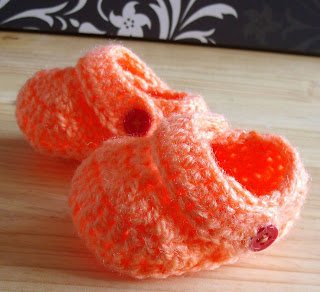I have been asked several times for the pattern to make these baby crocs.
SO HERE THEY ARE!
Want this as a printable pdf? Get it here
This pattern is given for free, but of course I would love it if you would donate something for the time I've put into this for you.
You can do what you want with the finished piece, apart from mass production. But the pattern itself is mine and cannot be sold or shared without my permission.
Australian/British terms
To fit newborn size
8 ply wool, 4mm hook
Starting with sole
Rnd 1 - Ch 11, 1 htr in 2nd ch from hook, 1 htr in each of next 8 ch, 3 htr in last ch, Now working on other side of chain: 1 htr in each of next 8 ch, 2 htr in last ch, slst to join in 1st htr. (22sts)
Rnd 2 - Ch 2 (counts as a htr) 1 htr in same st as joining, 2 htr in next st, 1 htr in each of next 8 sts, 2 htr in each of next 3 sts, 1 htr in each of next 8 sts, 2 htr in last st, slst to join in top of ch-2. (28sts)
Rnd 3 - Ch 2, 1 htr in same st as joining, 2 htr in each of next 2 sts, 1 htr in each of next 6 sts, 1 tr in each of next 3 stitches, 2 tr in each of next 7 sts, 1 htr in each of next 7 sts, 2 htr in each of last 2 sts, slst to join in top of ch-2. (40sts)
Sides
Sides
Rnd 4 - Work this row in the loop behind the back loop, see video here: http://www.mooglyblog.com/third-loop-half-double-crochet/, 1 ch, 1 dc in same st, 1 dc in each of next 14 sts, 1 htr in each of next 15 sts, 1 dc in each of next 10 sts, slst in first dc to join. (40 sts)
Rnd 5 – Working in both loops, 1 ch, 1 dc in same st, 1 dc in each of next 11 sts, 1 tr in each of next 19 sts, 1 dc in each of next 9 sts, slst in first dc to join (40 sts)
Rnd 6 – 1 ch, 1 dc in same st, 1 dc in each of next 13 sts, 2trtog 4x, 1 tr in each of next 2 sts, 2trtog 4x, 1 dc in each of next 8 sts. slst in first dc to join (32 sts)
Rnd 7 – 1 ch, 1 dc in same st, 1 dc in each of next 12 sts, 2htrtog 6x, 1 dc in each of next 7 sts, slst in first dc to join
Rnd 8 - 1 slst across each of next 11 sts, 1 tr in each of next 2 sts, 2trtog 3x across front, 1 tr in each of next 2 sts, slst in each of next 4 sts, slst in first slst to join.
Fasten off.
Work straps separately
Straps (worked separately) – 23 ch, 1 tr in 4th chain from hook, 1 tr in next st, 1 htr in each of next 15 sts, 1 tr in each of last 3 sts. Working over post of tr just made, 1 ch, 3 dc over tr just made, 1 slst in next 19 sts across starting ch, 3 dc over 3 ch at other end, 1 slst in each of next 19 sts along top edge. Slst to join.
Fasten off
Sew buttons in place on foot section
Created by Jenny Lawson
For any questions, email me at: craftcove@gmail.com
More tutorials can be found at: Jewellery from Craft Cove http://craftcove.blogspot.com/
Please do not distribute, lend or copy.
Do not mass produce.
Copyright 2016 Jenny Lawson


















































